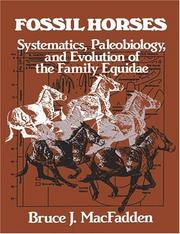| Listing 1 - 10 of 11 | << page >> |
Sort by
|
Book
ISBN: 2040199896 9782040199890 Year: 1994 Publisher: Paris Bordas
Abstract | Keywords | Export | Availability | Bookmark
 Loading...
Loading...Choose an application
- Reference Manager
- EndNote
- RefWorks (Direct export to RefWorks)
Le guide visuel de plus de 300 races de chevaux à travers le monde.
Book
Year: 1979 Publisher: New Haven, CT Peabody Museum of Natural History, Yale University
Abstract | Keywords | Export | Availability | Bookmark
 Loading...
Loading...Choose an application
- Reference Manager
- EndNote
- RefWorks (Direct export to RefWorks)
Horses, Fossil --- Paleontology --- Paleontology
Book
ISBN: 9519481508 Year: 1997 Publisher: Helsinki Finnish Zoological and Botanical Publishing Board
Abstract | Keywords | Export | Availability | Bookmark
 Loading...
Loading...Choose an application
- Reference Manager
- EndNote
- RefWorks (Direct export to RefWorks)

ISBN: 3412319716 Year: 1971 Publisher: Köln Böhlau Verlag
Abstract | Keywords | Export | Availability | Bookmark
 Loading...
Loading...Choose an application
- Reference Manager
- EndNote
- RefWorks (Direct export to RefWorks)
Horses, Fossil. --- Horses --- Paleontology --- History. --- Horses, Fossil --- Quaternary Period --- Equus caballus --- Farriery --- Hippology --- Horse --- History --- Equidae, Fossil --- Domestic animals --- Equus --- Livestock --- Pachyderms --- Hinnies --- Mules
Book
ISBN: 2871490589 9782871490586 Year: 2007 Volume: *11 Publisher: Treignes Centre d'étude et de recherches archéologiques
Abstract | Keywords | Export | Availability | Bookmark
 Loading...
Loading...Choose an application
- Reference Manager
- EndNote
- RefWorks (Direct export to RefWorks)
Horses in art --- Paleontology --- Chevaux dans l'art --- Paléontologie --- History --- Exhibitions --- Histoire --- Expositions --- Paléontologie --- Horses --- Mythology

ISBN: 0521340411 0521477085 9780521340410 Year: 1992 Publisher: Cambridge University Press
Abstract | Keywords | Export | Availability | Bookmark
 Loading...
Loading...Choose an application
- Reference Manager
- EndNote
- RefWorks (Direct export to RefWorks)
General palaeontology --- Mammals --- Horses, Fossil --- Chevaux fossiles --- Equidae --- Equidae, Fossil --- Horses --- Paleontology --- Evolution --- Classification --- Paléontologie --- Caenozoic Era --- Cainozoic Era --- Cenozoic Era --- Equus caballus --- Farriery --- Hippology --- Horse --- Equids --- Domestic animals --- Equus --- Livestock --- Pachyderms --- Hinnies --- Mules --- Perissodactyla --- Perissodactyla, Fossil --- Horses, Fossil. --- Cénozoïque. --- Horses - Evolution --- Paleontology - Cenozoic --- Equidae - Classification --- Equidae - Evolution --- Horses - Classification
Book
ISBN: 9783319558769 3319558765 3319558773 Year: 2017 Publisher: Cham : Springer International Publishing : Imprint: Springer,
Abstract | Keywords | Export | Availability | Bookmark
 Loading...
Loading...Choose an application
- Reference Manager
- EndNote
- RefWorks (Direct export to RefWorks)
This book provides an update on the phylogeny, systematics and ecology of horses in South America based on data provided over the past three decades. The contemporary South American mammalian communities were shaped by the emergence of the Isthmus of Panama and by the profound climatic oscillations during the Pleistocene. Horses were a conspicuous group of immigrant mammals from North America that arrived in South America during the Pleistocene. This group is represented by 2 genera, Hippidion and Equus, which include small species (Hippidion devillei, H. saldiasi, E. andium and E. insulatus) and large forms (Equus neogeus and H. principale). Both groups arrived in South America via 2 different routes. One model designed to explain this migration indicates that the small forms used the Andes corridor, while larger horses used the eastern route and arrived through some coastal areas. Molecular dating (ancient DNA) suggests that the South American horses separated from the North American taxa (caballines and the New World stilt-legged horse) after 3.6 - 3.2 Ma, consistent with the final formation of the Panamanian Isthmus. Recent studies of stable isotopes in these horses indicate an extensive range of 13C values cover closed woodlands to C4 grasslands. This plasticity agrees with the hypothesis that generalist species and open biome specialist species from North America indicate a positive migration through South America.
Horses, Fossil --- Horses --- Paleoecology --- Paleontology --- Palaeoecology --- Ice Age --- Pleistocene Epoch --- Equus caballus --- Farriery --- Hippology --- Horse --- Phylogeny. --- Dispersal --- Equidae, Fossil --- Ecology --- Paleobiology --- Domestic animals --- Equus --- Livestock --- Pachyderms --- Hinnies --- Mules --- Paleontology . --- Animal ecology. --- Paleontology. --- Biogeosciences. --- Animal Ecology. --- Animals --- Zoology --- Fossilogy --- Fossilology --- Palaeontology --- Paleontology, Zoological --- Paleozoology --- Historical geology --- Fossils --- Prehistoric animals in motion pictures --- Geobiology. --- Biology --- Earth sciences --- Biosphere --- Phylogeny
Book
ISBN: 2913853021 Year: 2001 Publisher: Nemours : Musée de préhistoire d'Ile-de-France,
Abstract | Keywords | Export | Availability | Bookmark
 Loading...
Loading...Choose an application
- Reference Manager
- EndNote
- RefWorks (Direct export to RefWorks)
Horses
---
Domestic animals
---
Animal remains (Archaeology)
---
Chevaux
---
Animaux domestiques
---
Restes d'animaux (Archéologie)
---
Origin
---
Origine
---
Animals and civilization
---
-Horses
---
-Prehistoric peoples
---
-#BIBC:ruil
Book
ISBN: 9780198749233 0198749236 Year: 2018 Publisher: Oxford, United Kingdom Oxford University Press
Abstract | Keywords | Export | Availability | Bookmark
 Loading...
Loading...Choose an application
- Reference Manager
- EndNote
- RefWorks (Direct export to RefWorks)
Donkeys carried Christ into Jerusalem while in Greek myth they transported Hephaistos up to Mount Olympos and Dionysos into battle against the Giants. They were probably the first animals that people ever rode, as well as the first used on a large-scale as beasts of burden. Associated with kingship and the gods in the ancient Near East, they have been (and in many places still are) a core technology for moving people and goods over both short and long distances, as well as a supplier of muscle power for threshing and grinding grain, pressing olives, raising water, ploughing fields, and pulling carts, to name just a few of the uses to which they have been put. Yet despite this, they remain one of the least studied, and most widely ignored, of all domestic animals, consigned to the margins of history like so many of those who still depend upon them. Spanning the globe and extending from the donkey's initial domestication up to the present, this book seeks to remedy this situation by using archaeological evidence, in combination with insights from history and anthropology, to resituate the donkey (and its hybrid offspring such as the mule) in the unfolding of human history, looking not just at what donkeys and mules did, but also at how people have thought about and understood them.
Donkeys --- Mules --- Mammal remains (Archaeology) --- Mammalian remains (Archaeology) --- Mammals in archaeology --- Animal remains (Archaeology) --- Archaeology --- Livestock --- Horses --- Ass, Small --- Burros --- Domestic ass --- Equus africanus asinus --- Equus asinus asinus --- African wild ass --- Equus --- Hinnies --- History --- Methodology
Book
ISBN: 9782960076998 2960076990 Year: 2017 Volume: 28 Publisher: Louvain-la-Neuve Université catholique de Louvain
Abstract | Keywords | Export | Availability | Bookmark
 Loading...
Loading...Choose an application
- Reference Manager
- EndNote
- RefWorks (Direct export to RefWorks)
"Certains domaines d’expertise ont un caractère plus réservé que d’autres et leur histoire est de ce fait plus difficile à retracer : c’est le cas de l’art vétérinaire, pourtant essentiel dans toute société depuis la nuit des temps. L’originalité du colloque qui s’est tenu à Louvain-la-Neuve au printemps de 2011 était de ne pas se limiter aux sources strictement vétérinaires, où le cheval se taille la part du lion, mais d’étendre le champ d’investigation aux textes cynégétiques, qui incluent régulièrement des indications thérapeutiques relatives aux fidèles compagnons du chasseur, les faucons et les chiens. Les articles, rédigés par des chercheurs d’horizons divers – philologues, historiens, historiens de l’art –, apportent un éclairage multiple et contrasté sur l’art de soigner les animaux dans l’Antiquité et le Moyen Âge européens et attestent le regain d’intérêt que connaît son étude. À côté des acquis que présentent d’ores et déjà ces recherches, celles-ci soulèvent maintes questions et montrent à quel point l’histoire de la médecine vétérinaire tire profit d’un horizon élargi et décloisonné"--Publisher's website.
Veterinary medicine --- Hunting --- Falconry --- Horses --- Dogs --- Birds of prey --- History --- Early works to 1800 --- Wounds and injuries --- Treatment --- Diergeneeskunde --- Jacht. Visserij. Aquacultuur --- Oudheid --- anno 500-1499 --- Hunting. Fishery. Aquaculture --- Antiquity --- Manuscripts, Medieval --- Farriery --- Large animal medicine --- Large animal veterinary medicine --- Livestock medicine --- Veterinary science --- Medicine --- Animal health --- Animals --- Domestic animals --- Livestock --- Manuscripts --- Diseases --- Losses
| Listing 1 - 10 of 11 | << page >> |
Sort by
|

 Search
Search Feedback
Feedback About
About Help
Help News
News